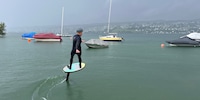
Background information
Nine SUP details you need to know
by Michael Restin

Whether it’s equipment, maintenance, regulations, nature protection or self-protection, fun on the water is preceded by an information tsunami. Dive into these issues, and your time on the lake or river won’t turn into a damp squib.
We’re approaching that time of year again. The time of year when fair-weather water sports enthusiasts like myself rouse their inflatable boats, kayaks or SUP boards from hibernation. This tends to be a euphemism for «yank them out from behind the skis in the corner of the basement». That’s how I did things for a long time. In the last few years, however, I’ve learned to do things differently.
Storing your water sports kit appropriately helps to extend its lifespan. Simply put: if they’re clean, dry, protected from sunlight and, ideally, slightly inflated, SUP boards and the like have a better chance of growing old in their storage spots and staying unscathed. Boards shouldn’t be left on the lakeshore to bake in the sun unnecessarily, either. Not if you care about the material and the seams. Your board is also definitely worth checking over if it’s been in storage for a while. Is everything still watertight? Are the valves in working order? Sometimes, the devil’s in the detail, and a close look at the right time will save you some frustration later. One thing I’ve learned from both my own experience and my visit to Indiana Paddle & Surf is that no mistake is too obvious to have been made.
It’s also worth getting some information before buying new kit. SUP boards especially are still as popular as ever. There’s a wide range of prices, the models look cool and the differences between them aren’t obvious at first glance. While phrases such as «double layer», «welded rail tapes» or «fusion material» all make for good reading, they can be confusing, too. Most people go for an inflatable all-round or touring model without knowing the ins and outs of the board itself. Although these aspects are similar across brands, they’re not the same. On the budget end of the scale, savings are made on drop stitch material. They’re the threads which provide stability by connecting the upper and lower decks. In the article below, you’ll find more insights and explanations on that.
Another thing that’s tricky to grasp, yet fundamental, is the Inland Navigation Ordinance (linked site in German). This spells out what’s permitted with what kind of boat or board, and what the regulations are around equipment. Reading it isn’t as sexy as a day on the lake, but it’s a prerequisite for everything else. Here I’ve summarised for you, among other things, what’s meant by «beach boats», «inflatable boats», and «competitive sports equipment», and why this distinction is important.
Generally speaking, you should check with the local authorities about rules for behaviour on the water, special provisions for your sport and any regional specifics. For hotspots like the Aare, there are also detailed guides (linked site in German) with applicable rules, routes and tips for a successful day.
This also involves respecting restrictions. Yellow buoys or signs indicate nature reserves, which you can’t sail or paddle into. You can get clued up on protected habitats in advance, for example by checking the federal government’s Geoportal. At Kanuland Schweiz or paddle-spots.com, you’ll find routes and plenty of other useful information on being safe and in harmony with nature when you’re out on the water. Basically, you should avoid stressing out birds and other wildlife too much. While stand-up paddling especially, you’re perceived as a threat from surprisingly far away.
The issue has caused a stir in recent years (linked article in German). What’s classed as toeing the line? And what’s a step too far? Some rules are set officially, while others are informally set through being considerate while paddling (linked information in German).
Even if you follow all the rules, are well prepared and have the optimal kit and weather conditions, water sports always carry a slight risk. If you know and follow both the Inland Navigation Ordinance and the bathing and river rules of the SLRG, you’ll be prepared (linked content in German). Nevertheless, situations could still arise where you need help or could help others. With the latter, the «lowest risk rescue» principle applies (linked information in German). Alert other helpers, provide assistance if you can and don’t put yourself in danger. The SLRG rescuers are specially trained for emergencies. In the following article, you can see what happens during a water rescue on the Rhine.
Simple writer and dad of two who likes to be on the move, wading through everyday family life. Juggling several balls, I'll occasionally drop one. It could be a ball, or a remark. Or both.
Interesting facts about products, behind-the-scenes looks at manufacturers and deep-dives on interesting people.
Show all
Background information
by Michael Restin

Background information
by Patrick Vogt

Background information
by Siri Schubert